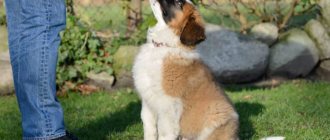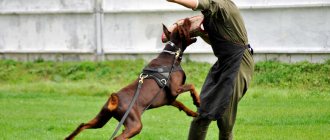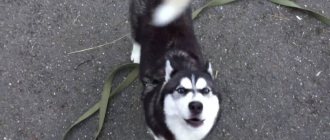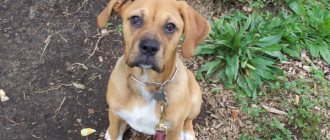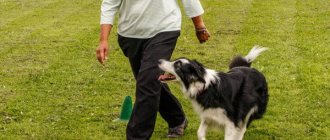The “Fu” command is practiced through coercion or, to be more precise, punishment, since the impact on your part always comes after some action of the dog. Usually the “Fu” command begins to be used at a very early age, when the puppy is playing too much. At the same time, it is recommended to start serious training from 6 months, when the pet learns the commands "Sit", "To me" and learn to trust you completely. It is highly not recommended to put pressure on a puppy until it is six months old; just try to avoid situations that provoke your pet into non-forbidden actions. Since training the “Fu” command is based on punishment, it will not be able to bring joy to the dog, and if you go too far, your dog will simply break.
Also remember that even very well-trained dogs flawlessly execute the “Fu” command only when they begin to do something. If the dog is already fully engaged in an unwanted action, then it will be much more difficult to stop it. For example, if a dog takes leftovers in its mouth, then when it hears your exclamation, it will not spit out the food, but will try to swallow it quickly. Thus, you cannot delay giving the “Fu” command; this is one of the biggest mistakes.
What is the "fu" command for?
This skill can be used in a wide variety of everyday situations. First of all, the “fu” command means that the dog is prohibited from doing any action. As a rule, we say “ugh” to our pet when we don’t want the animal to grab food that is not desirable or even dangerous to its health.
It is quite possible that in an emergency, the “fu” command will save your pet’s life. Dog hunters may spread poison throughout the streets or even try to feed your pet a poisonous treat directly from their hands!
Or, for example, the guests at the table decided to treat the dog to fried chicken, suspecting nothing, but the dog could then develop health problems! It is in such situations that the “fu” command is incredibly relevant.
Step-by-step training of the “Fu” command
If you are currently working on another command, you need to finish with it first, then proceed to the rest of the commands.
Stage #1: Team Basics
Start training outside the court territory and on a short leash. The owner must plan the route in advance so that prohibited items are nearby. For example, pigeons, cats or leftover food. Professional trainers specially place various tasty treats (sausages, pieces of meat, etc.) along the entire route. Therefore, you can take a friend with you, who, unnoticed by the dog, will place pieces of doctor’s sausage along the route (you can also take another treat, this is indicated as an example for greater understanding). Practice the command every day on different routes; prohibited items can be the same or replaced as the owner himself wants.
After the path has been selected and everything has been planned, walk along it. The speed is below average so that the animal has time to react to changes in its surroundings. As soon as the dog rushes towards the sausage left in advance, say a hard “Ugh” and pull the leash. If everything is done correctly, the dog will be distracted and then continue to follow the owner. Literally after a few steps, give another command that it already knows. Be sure to reward in case of strict execution. There is no need to reward the “Fu” command.
During the entire walk, do not repeat the command more than 5 times, the time interval is 14 minutes. At first, you shouldn’t raise your voice at the dog; you can do this later, when you get used to it a little. The command "Fu" means a complete ban. Do not use in other situations when a different order is needed. Some dogs hardly pay attention to a tug on the leash, let alone commands. What to do in such a situation? If the dog is a large breed (German Shepherd, Moscow Watchdog, Alabai, etc.), when teaching this command, use a strict electronic collar, but a rolled up newspaper will also do. If you ignore the jerk of the leash, lightly slap him on the neck, but you need to be careful, the animal may become aggressive. But at the same time, the owner should always know one elementary rule: first say a firm “Fu,” then jerk the leash, then clap the newspaper. If the dog reacts to the command, you do not need to do anything, just the same if it reacts to the leash.
Stage No. 2: Honing the skill
By reaching this stage, the dog should already be able to carry out the given command well. Now you need to lay out a route in a busy place where other animals or people will be walking. The skill can be considered completed when the dog stops its action on the orders of its owner. After this, put him on a long leash and start practicing the command over a longer distance. In this case, there is no possibility of influencing the newspaper.
When the dog immediately shows a reaction at a great distance, then it is possible without it, but the owner must be sure that the dog will not attack random people passing by. Starting in a quiet environment and at a minimum distance from each other, the dog already understands perfectly well what awaits him in case of disobedience. If you want to train a dog over a longer distance, for example, at a distance of 15 meters, you will have to spend a lot of time and effort.
The difference between the commands “fu” and “no”
The dog must clearly understand: what action does this or that command indicate? To do this, you must understand what is the difference between the command “fu” and “no”.
The “fu” command is used to prohibit an animal from picking up/taking certain food from the floor/hands.
“No” is used as a prohibition for a provoked animal to perform any action: running after a cat, jumping on the owner and guests, climbing on the sofa, chasing birds, and so on.
When might you need the "Fu" command?
The use of the “Fu” command is not limited to the prohibition of chewing furniture or barking at other animals. There are still a lot of actions that need to be stopped as early as puppyhood. Let's try to prove the need to teach a dog the "Fu" command using situations that each of us may encounter in everyday life.
A large breed dog puts its paws on its owner with joy
- All dogs are happy when their owner comes home. Having missed you, the pet meets you at the threshold and begins to jump up to your face with joy, placing its paws on clean clothes. It’s unpleasant when a toy terrier behaves like this. And if this is a German Shepherd, the consequences for you and your clothes can be sad: a torn jacket, traces of dirty paws and bruises on the body.
- The most loving and friendly animals can show their natural instincts. Dogs are often aggressive towards people who are drunk or smoking, as well as children who scream or squeal loudly. You may not notice how the dog bares its teeth or rushes at a pedestrian it doesn’t like. Does anyone need victims and problems with the police?
- While walking without a leash, the dog may find something edible on the ground. It can be not only garbage, but also poison for homeless animals. The consequences can be tragic: from poisoning to death.
- Showing the best security qualities, a dog can bark for a long time when it hears the slightest rustle outside the front door. Constant barking, heard at any time of the day, will not please you or your neighbors.
With the help of the “Fu” command, you can avoid all these troubles, be it aggression towards passers-by or joyful jumping on the owner. And these are just a few examples of situations - in reality there are many more.
Important knowledge for dogs
There is a known list of commands for training dogs. There are about a dozen common ones, the rest are specific job skills that are unsuitable in everyday life. The list of tasks looks something like this:
- "Place". A universal task that every dog must know.
- "Near". The skill is important, it allows you to keep the dog nearby during walks.
- "Sit". A common skill used everywhere.
- "Lie". Used less often than the previous ones, popular.
- "Die." Useless from a household point of view, but perfectly disciplines the dog.
- "Give". An important command that allows you to take away an unnecessary or harmful item from your dog.
- "Aport." Develops the physical condition of the dog, affects hunting and search instincts.
- "To me". The most important task to return the dog to its owner. Developed to the point of automaticity, the dog is ideally designed to completely ignore other factors.
- "Fas." Extremely complex, requiring the owner to have the highest degree of control over the animal.
- "Ugh". A universal command developed to the point of automaticity.
- "Voice". The dog begins to bark at the owner's request. Considered useless.
- Excerpt. It is difficult to call the state a command, but endurance - the dog’s ability to sit still and guard things or wait for the owner - is the highest aerobatics of canine art, the highest level of dog education.
At what age should you teach?
Teaching commands such as “fu” and “no” should not be taught using rigid methods. Once the puppy has arrived at your home and is comfortable (typically between 1.5 and 3 months of age), you can begin training him.
The lesson should be held in an easy and playful manner.
If you decide to start training an adult animal, then do not think that this will be a difficult and impossible process. Absolutely every dog can be trained.
Basics of teaching a dog the command No or Fu
You will smile, remembering this article, when the fluffy ball appears in your home. Oh, how often will you exclaim in your hearts: “You can’t!”, “Ugh!”, “What are you doing!”, “Spit!”, “Get away!” At times, you will even feel ashamed: “What kind of parent am I that I forbid everything, it’s tiny.” But these are lyrical emotions that have no place in a dog’s adult life.
Remember, you cannot train your dog to obey a command; it means protecting and caring for you, not punishing him! The first steps in the science of obedience begin at home, long before the puppy is vaccinated and starts running outside. By 4 months, the baby should understand Fu’s command, even if not follow it 100%, but the strict, harsh tone should prompt the child to think: “Is it worth it?”
When is it necessary to avoid prohibitions?
The word “impossible” will save order in the house, preserve the health and even the life of a four-legged pupil. A basic order is necessary in a number of emergency situations:
- when the pet tries to pick up an inedible object (stick, stone, bag) or harmful products (bones, rotten meat or excrement) from the ground;
- when trying to escape from the owner, run out onto the roadway;
- if desired, chase moving objects (bikers, cyclists, runners, children, cats);
- with the intention of getting closer to homeless relatives.
Like the “SOS” signal, the prohibitory command is designed to prevent poisoning or infection with a dangerous infection, tragic death under the wheels of a car and other force majeure.
Main nuances
Many owners of four-legged dogs think that the “fu” and “no” skills are those commands that the owner should always pronounce in a harsh and rude tone, and that the dog should associate these exercises with something unpleasant.
Let's look at this from a different perspective. Surely you have encountered situations where other people raised their voices at you. Remember, did you want to fulfill their demands at those moments?
Has your respect and trust for these people increased? Of course no. In this regard, human logic is no different from dog logic.
Training should always be done on a positive basis, no matter what team you are learning.
The commands “fu” and “no” should be associated in the dog not with a prohibition (although this is exactly what we mean), but with a distraction towards the owner.
A pet, hearing the command “fu,” should not think: “I really want to eat this, but I’m about to get some from the owner, so I’ll definitely do it when he’s not around,” but on the contrary: “yes, this food is delicious, but I’m better.” I’ll look at my owner, and he’ll give me twice as much, and he’ll also praise me and play with me.”
- The lesson should be carried out in a room familiar to the dog. At the first stages, on the street, it is likely that the dog will be distracted by external irritating factors: cars, children, cats, people, birds, dogs, and so on.
- Do not feed your pet several hours before training. A well-fed animal will not want to make attempts to obtain food, and accordingly, training a pet in this state will not bring a positive result.
- Work with your four-legged dog only when you yourself are in a good mood . Being in good shape, you convey this state to the dog, and it works with a greater degree of positivity and motivation.
- Conduct a lesson with a cheerful animal. If your pet, for example, walked in the forest for half a day or spent a lot of time in a training session, give him a rest and reschedule the training for another day. A tired dog will not strive to work to the best of its ability.
- Consider your pet's wishes and mood . It often happens when a dog is not in the mood for work, but he really wants, for example, to play. So why not offer your pet a game? It is important not to overdo it and not give the dog constant indulgences.
General training course for a competent dog
The concept of a literate dog defines a dog that knows the initial commands and carries out orders at the request of the owner. Agree, you don’t want to have a stupid, ill-mannered individual in your house. However, there are no stupid animals, but there are lazy owners and inexperienced owners. The general training course includes the acquisition of skills:
- Calm walking with the owner.
- Knowledge of the “Come to me” command and complete execution.
- The dog must know that it is forbidden to take treats from strangers. You can't pick up food from the ground.
- On command, stop performing unwanted actions.
- It is recommended to instill normal perception of shots in hunting and working breeds. The dog shouldn't be afraid.
If you decide to teach your animal commands on your own, make sure you have: collars - soft and strict (for large and service breeds), leashes - short and long, it is advisable to use your pet’s favorite toy. Before the start of constant training and learning basic commands, the animal must be able to do something. In particular, the dog must respond to the name and allow the collar to be put on and taken off calmly.
The nuances of executing the command: No or Fu
To hit or not to hit? - Decide for yourself, there are alternatives - parfors, training choke collars, compressed air cans (football pipes), ultrasonic whistle, EShO (electric collar), and the most humane thing - patience, perseverance, rigor. It’s worth it and the “sneaks” will quickly understand what they want from them and how to deceive the owner - be prepared. Conditional standards for executing the Fu command:
- The command is mandatory for a dog of any breed, size, psychotype, age!
- The dog stops unwanted actions on command and does not return to them as soon as the owner turns away (pseudo-compliance).
- The ward knows that disobedience is followed by punishment, and most importantly, negative emotions of the owner.
- The command can be given by all family members and people living in the same room as the animal.
- Choleric and hyperactive dogs are trained in the “Ugh, Sit!” complex; fixing the pose helps the pet to restrain itself.
Ways of learning
These methods are based on positive reinforcement and are equally suitable for both a puppy and an adult dog.
Method 1
- Prepare 2 types of treats: one delicious, the other even tastier. Think about which treats your pet likes the most and which ones a little less.
It is important to choose something that the dog still likes as a less tasty treat, otherwise it will be of no use.
- Take your pet on a leash (preferably with a harness) or find an assistant who can hide food from the dog at the right time.
- Show the animal that you have food and place a piece of a less tasty treat on the floor. Don't let your dog grab the treat (use a leash or have a helper close the treat). At first, the pet will try in every possible way to get close to the treat - ignore this behavior. As soon as you see that the dog has been distracted from its goal for a second (turned around, looked at another point or at you), immediately feed your pet a more tasty treat from your hands. Repeat this several times until the dog understands that trying to get food from the floor will not bring him anything good, and distraction from the treat on the ground, on the contrary, entails encouragement from the trainer.
- Gradually, you can increase the criteria. Now you need the dog to be distracted from food in your direction. As soon as your pet is distracted from food and looks at you (ideally in the eyes), give him a tasty treat from your hands.
- If the previous steps are completed successfully and the dog understands the task, enter the voice command “fu”.
- Practice the exercise without a leash and an assistant. You can use other treats and practice the skill in different environments.
Method 2
- Take a treat and hold it in your fist. First, let your dog sniff the treat without giving it away.
- Squat down in front of your dog, holding your fist at the level of his nose. The dog will try to get food by licking his fist. Perhaps your pet may start barking. At this point, your job is to wait and monitor the behavior you want. The desired behavior means distracting the dog from the fist with food. As soon as the dog turns away, sniffs the ground or begins to do any other actions, distracted from the treat, immediately open your palm and praise the pet. Repeat this several times until the animal understands what is required of it. You must explain to the dog that he will receive a treat only at the moment when he does not look at your fist in which the treat is clutched.
- Gradually increase the criteria. Make sure that the dog does not look at a specific object other than a fist, but at you. Encourage all eye contact. Give your dog a chance to think and wait for him to look you in the eye. As soon as you catch her eye, praise her. After several such attempts, increase the duration of the gaze. First treat your pet after a second of eye contact, gradually moving to two, three, four or more seconds.
Just don’t overdo it and don’t make the activity too monotonous and boring.
- Once your pet has mastered the skill well, enter the voice command “fu”. Ultimately, you will come to the point that a pet that sees forbidden food will not try to eat it, but rather will turn to you in anticipation of praise.
Teaching the puppy the “Fu” command
The puppy is rewarded with a treat
It may seem to a novice dog owner that the “Fu” command is the easiest command for a dog to learn. Statistics show the opposite: it is easier to teach an animal to perform a certain action on command than to prohibit it with one word from doing something unwanted. That is why teaching a dog the “Fu” command should be systematic and step-by-step.
Recommendations
- Dog trainers advise starting training while walking. You should choose a relatively quiet place that is familiar to the dog, without unnecessary stimuli (people, cars, dogs). A prerequisite when choosing a location is the presence of prohibited objects (garbage, birds).
- If there are no prohibited objects, they can be specially prepared and scattered in advance. Another option is to take a friend for a walk who will scatter prohibited objects. This could be a dog treat, pieces of sausage or sausage, bones, etc. Under no circumstances should you throw anything that could endanger other people and dogs.
- It is necessary to change training places as often as possible. The dog must carry out the command in different conditions, without perceiving it only in one specific place.
- The animal must be on a loose leash.
- You can't speed up your pace. At a fast pace, you are unlikely to be able to fully control what is happening.
- The “Fu” command is given no more than 5 times per walk at intervals of at least 10 minutes.
- The command “Fu” is given in a calm voice, clearly and only once. Yelling at an animal is strictly prohibited.
- You shouldn't make the "Fu" command universal. It is used when you need to give the dog a complete, categorical ban, and not “slow down” any action. You cannot substitute other commands
- You cannot give a dog a treat for following the “Fu” command. You can reward her later (read below on how to do this).
- If you prohibit something using the “Fu” command once, do it in the future. It must be clearly defined for the dog what can and cannot be done.
- The dog should follow the “Fu” command when it hears it from any member of your family.
- You need to give the command “Fu” with lightning speed, at the moment of an unwanted action.
Step by step training
The owner stops the dog by saying the command “Fu”
- Following all the recommendations, decide on the place and time of training. Find out if there are any dog-friendly items in the area. Prepare prohibited items if required by the activity location.
- Go to the training area at a relaxed pace. Remember: no “Fu” command on the way to the first lesson. If you need to prevent an unwanted action, use a leash and pull the dog back.
- Knowing in advance where the prohibited objects are, head towards them. When the dog reaches for something that it should not take, strictly say “Ugh” and tug the leash quite firmly (comparate the strength of the tug with the size of the animal). First the command must be given and only then the jerk must be made.
- When the dog becomes distracted by your influence, continue moving. The dog should follow you. If she again concentrates her attention on the forbidden object, you should repeat the command “Fu” and pull the leash again, but this time stronger.
- Large breed dogs may not respond to tugs. In this case, it is worth taking more stringent measures - using a strict collar, a noose or an electronic collar.
- There are several steps to follow. If the dog knows the “Sit” command, you need to give it. Only after this can the animal be treated with a treat.
This procedure is repeated throughout the walk. You should not plan to repeat the “Fu” command more times and at fewer intervals than indicated in the recommendations. But if on the way home the dog does something that needs to be stopped with the command “Fu” - stop it.
Training rules
In order for a dog to master both commands, the owner must be an authority for it, a kind of leader. She will not listen to a weak and inconsistent boss. Among the representatives of the canine families there are many individuals who prove their superiority to the owner and take the initiative for education into their own paws.
And yet, every breeder can teach a pet both commands at home. Orders need to be processed only when necessary and appropriate. At the same time, training is often based on both encouragement and the development of a passive-defensive reaction. The techniques used in training are:
- sharp tugging of the leash (without going too far);
- gentle lashes (not to be confused with beating);
- throwing light objects towards the disobedient animal (not at it, but nearby);
- tugging on a tight collar.
The use of such measures causes some discomfort to the disobedient animal. To get rid of unpleasant sensations, the pet is forced to obey orders. Having a good memory, in the future the dog will understand that disobedience will be punished. So she will think before doing wrong.
There are several ways to teach an animal prohibition commands. The choice of any of them will be based on criteria such as the age of the pet and the type of its nervous activity. For example, this could be a dog breeding technique used in official practice. The skill begins to be developed in the place of distracting stimuli to which the pet simply cannot help but react.
The puppy seems to be walking, but at the same time he is being held on a short leash. The teacher carefully monitors his behavior and tries not to interfere with movement in any direction. As soon as the dog decides to rush to the source of the stimulus, it is necessary to pronounce a prohibiting command. They pronounce it loudly and clearly, sharply pulling the leash towards themselves.
With the amateur method of teaching the “no” command, the owner begins training by sitting in front of the pet on a small elevation. He holds a treat in his hand, attracting the puppy's attention. As soon as the baby starts trying to get the tasty treat, they say the command “no”. If the animal refuses to endure and continues to win the treat, the palm is removed, and the puppy is taken by the scruff of the neck, slightly lifted and sharply lowered to the ground.
At the same time, you should not hit your pet: it is important that the baby is offended. At first he will persist, but if he loses interest, they say the command “maybe” and give him a treat. There should be no more than three repetitions per session. Over time, the task is made more difficult by keeping the treat open, but not giving it in case of disobedience. Afterwards, the tasty treat is placed on the floor, and then the commands “not allowed” and “possible” are completely mixed.
How to teach a dog the Fu command
It may seem to many that teaching a dog to stop an unwanted action with the command “Fu” is quite simple. However, this is not the case, and as practice shows, it is much easier to train a dog to do something on command than not to do something.
The fact is that in the first case you show exactly what you want, while the second case is an abstraction, and dogs perceive abstraction very poorly. Therefore, to achieve perfect execution, you will have to work hard, but it is worth it.
So, let's look at how to teach a dog the “Fu” command.
The “Fu” command is practiced through coercion or, to be more precise, punishment, since the impact on your part always comes after some action of the dog. Usually the “Fu” command begins to be used at a very early age, when the puppy is playing too much.
At the same time, it is recommended to begin serious training from 6 months, when the pet learns the commands “Sit” , “Come to me” and learns to completely trust you. It is highly not recommended to put pressure on a puppy until it is six months old; just try to avoid situations that provoke your pet into non-forbidden actions.
Since training the “Fu” command is based on punishment, it will not be able to bring joy to the dog, and if you go too far, your dog will simply break.
Also remember that even very well-trained dogs flawlessly execute the “Fu” command only when they begin to do something. If the dog is already fully engaged in an unwanted action, then it will be much more difficult to stop it.
For example, if a dog takes leftovers in its mouth, then when it hears your exclamation, it will not spit out the food, but will try to swallow it quickly. Thus, you cannot delay giving the “Fu” command; this is one of the biggest mistakes.
How to teach a dog the “Fu” command step by step
Teaching a puppy the “Fu” command is quite difficult, so if you are currently busy practicing some other command, you should finish it first. Also, if you have started learning the “Fu” command and have not yet completed all its stages, you should not start learning other exercises.
Stage 1: Fu Command Basics
It is recommended to start training outside the home and on a regular leash. For training, choose a calm route where there will be no too strong stimuli, but there will be forbidden objects, such as scraps or pigeons. When training professional dogs, trainers specifically place prohibited objects along the dog’s path.
If you wish, you can take a partner with you and ask him to place sausages or pieces of sausage in the path without the dog noticing. As with practicing other commands, when learning “Fu” it is recommended to change routes as often as possible.
Please note that for now there is no need to practice the “Fu” command for direct contact with other dogs or people; you will do this later.
When the route is chosen and everything is prepared, walk along it with the dog at a slower than average speed. You need to walk slowly so that both you and the dog have time to react to changing situations.
When a dog, walking on a slack leash, heads towards a prohibited object (for example, a sausage left in advance), strictly say “Ugh” and then give a sharp tug on the leash. But balance the force of the pull with the size of your dog.
At the same time, continue moving, the dog should be distracted for a moment, and then immediately resume moving behind you. After walking 2-3 steps, stop and give the dog a command, for example, “Sit” , and then give him a treat.
This is necessary so that the dog is distracted and relaxed, since sudden braking and your influence is a strong stress for him. Keep in mind that it is strictly prohibited to directly reward the execution of the “Fu” command!
During training, it is better not to give the “Fu” command more than 5 times per walk, and the interval between commands should be about 15 minutes (so that the dog has time to calm down). The command must be given strictly, but calmly and without threat.
In the first stages of training, do not yell at the animal under any circumstances; if the dog does not listen, use a leash. You can shout and bark at your pet only later, in cases where he does something completely unacceptable, and when he has already learned what actions are prohibited.
If the dog has learned the “Fu” command, but does not respond to it at your first word, then you can bark again.
If you have prohibited some action, for example, sniffing a pole, then under no circumstances allow this action after executing the command. You can let me sniff the next pillar, but not this one. Remember that the “Fu” command is a complete ban, not a brake.
Never use the "Fu" command if the situation requires a different command.
For example, if the dog grabbed your hat and does not give it back, say “Give” , if the dog is pulling on the leash, command “Near” , if the dog left by the backpack decides to stand up, say “Wait” .
Some ill-mannered dogs react poorly to a tug on the leash; it does not stop them. What to do then? If the dog is a large breed, such as a German Shepherd, then to teach it to the “Fu” command, use a strict or electronic collar. You can also use rolled up newspaper.
If the dog does not respond to the tug, slap him on the butt or neck with a newspaper. This almost always stops the unwanted behavior. Just don’t forget about the sequence: first the command “Fu!”, then a jerk with the leash, and only then the newspaper. If the dog reacts to the voice, then there is no need to pull the leash.
If you react to the leash, put the newspaper aside until next time.
Stage 2: honing the skill
When the pet begins to obey the command well, begin to complicate the conditions. Now practice the “Foo” command in busy places, in contact with other dogs or people.
The skill can be considered mastered when the dog stops any unwanted behavior at your first command. Only after this can you start practicing the “Fu” command at a distance and using a long leash.
In this case, you lose the opportunity to influence the newspaper, which is why you first need to train on a short leash.
When the dog begins to perfectly follow the command on a long leash, you can move on to off-leash training. In this case, it is better to start again in a quiet environment and at a short distance.
In general, the "Fu" command works best at a short distance, since the dog understands that it will immediately get hit in the neck .
If you want to train your dog to the “Fu” command at a distance of about 15 meters, you will have to spend a lot of time and effort.
Conclusion
Dogs forget skills very quickly, so if you are leading your pet on a leash and there is a need to prohibit something, say “Ugh” and be sure to demand that the command be followed, and do not just drag the dog away with the leash. Of course, it’s easier to drag him away on a leash, but the “Fu” command is very important, so don’t neglect to secure it.
When talking about how to teach a dog the “Fu” command, it is important to mention one more nuance. If the “Fu” command is practiced for absolutely prohibited things, for example, eating leftovers, then there will be no problems.
But if, for some reason incomprehensible to the dog, you forbid him to sniff a bush or do some other harmless action, then you become inconsistent for your pet, and this can greatly ruin your relationship. That is why you should seriously teach the “Fu” command only when contact has been established with the dog and it trusts you.
But if you often make mistakes during training, then you will not only fail to raise an obedient dog, but also the contact will be broken.
Attention! Training rules
- Do not use unnecessarily strong influences (jerk jerks, hits), especially at first.
- Always take breaks during the training process.
- Remember that you cannot first prohibit your dog from performing any action, and then immediately allow it a second later.
- Do not use the "Fu" command if another command can be used in this situation.
- Give the command in the first second, and not when the dog has already completely switched to the prohibited activity.
- Repeat the training periodically, as the skill is forgotten very quickly.
- Don't abuse the command or use it too often. A typical mistake is an attempt to prohibit not only undesirable actions at the moment, but also all actions that inspire fear that they may turn into such.
Source: https://dogtricks.ru/osnovnye-komandy/kak-nauchit-sobaku-komande-fu
Possible mistakes
- Praise your pet ahead of time. Train your reaction speed. Try not to praise your dog before he has fulfilled the desired requirement. Make sure to give the treat to your pet only when he takes his eyes off the forbidden food or your fist with the treat.
- Early introduction of voice command. Enter the “fu” command only when you are sure that the dog has mastered the skill. If you enter a command in the early stages of training, the animal will get confused and associate “fu” with something incomprehensible to it. After all, mistakes often happen early on, and your voice command will reinforce them.
- Pulling with a leash. Perhaps, when working on a leash, you will want to speed up the training process and physically pull the animal away from the forbidden piece of food. In this case, the dog does not learn to think and look for the right solution. You need the dog to turn towards you when he hears the command “fu”, and jerking the leash is unlikely to achieve this result.
- Long lesson. Training should be carried out in such a way that the dog wants to do it with pleasure. To do this, you don’t have to learn the “fu” command for a long time and monotonously. Between approaches, play with your pet and let him go for a walk and unload.
Don't let your workout get to the point of fatigue.
- Lack of your involvement in training. When training a pet, not only the result is important, but also the process itself. If you work with an animal without showing any positive emotions, the dog will also get tired of working. Praise your pet more diligently, rejoice with him when he succeeds at something. This way, the dog will associate training with something positive and fun, and he will happily look forward to the next lesson.
How to train an adult animal?
If the dog follows a prohibiting command, this allows you to avoid problems not only with neighbors, but also with scandalous individuals who are just waiting for a reason to take out their anger on others. A trained dog will not give the owner cause for concern. In a peak situation, she will wait for the right command to do the right thing.
Of course, it is easier to train a pet to obey in childhood. It is more difficult to train an adult dog, because it has already developed its character and, as is usually the case, has bad habits. If in such cases the animal refuses to obey, you can teach it prohibiting commands using an electronic collar.
The sequence of the training scheme is as follows: a command and immediately a jerk (slap with a newspaper for dogs that do not respond to jerks of the leash). You can’t quit classes if your pet doesn’t listen. By this the owner demonstrates his helplessness. You can’t delegate training to a dog handler, because then the owner will not be an authority to whom the dog must obey. If behavior requires correction, it is better to conduct classes under the supervision of a dog handler.
What does the "Fu" command mean?
Essentially, this command means a ban. Moreover, complete and categorical. As soon as the dog does something unacceptable, a prohibiting command must immediately follow.
This could be an attempt to rush at a person, start a fight with other dogs, pick up some kind of treat near the trash heap, an attack on the sofa or personal belongings of the owner. In all these cases, the animal must be stopped by firmly saying “Ugh!”
According to many dog handlers, the command is one of the most important, as it makes it easy to control the dog, regardless of its character and size.
Briefly about the main thing
- Conduct the lesson in a quiet and familiar place for the dog. The pet should not be too full.
- Hold the treat in your fist or place it on the floor, preventing your pet from grabbing it. Praise your dog only when he is distracted from the fist with food or the forbidden treat on the floor.
- Make sure that your pet not only is distracted from eating, but also looks at you. Once the dog understands the task, increase the time of eye contact.
- At the final stage of training, enter the voice command “fu”.
- Practice the skill in different places, using as many types of trigger foods as possible.
We hope that this article will help you resolve the issue of teaching your pet the “fu” command. You can rate the article or ask a question in the comments, we will definitely answer you! We wish you good luck in raising your pets.
Did you like the article? Share it with your friends on social media. networks. This will help them get useful information and support our project.
Patience comes first!
If you are planning to buy a pet, the best option would be advice from a dog handler. The master will certainly tell you which breed is best for you. It happens that people take an animal straight from the street, for example, they feel sorry for a homeless puppy or an adult dog.
The challenge will be to toilet train your pet. It is impossible to punish a dog with a “whip”, it will work against the owner. In order for the dog to listen and, most importantly, understand, you will need:
- remain patient;
- have perseverance;
- show affection.
These three parameters are extremely important in raising an animal! Especially in taming street dogs. Remember, street pets are much more difficult to train.
Carpets will have to be removed from the floor; dogs prefer soft coverings as a “toilet”. If the dog is large, the toilet is outside. It is necessary to develop a certain “toilet” routine for your pet. If successful, the pet will try to endure it until the walk or will begin to whine, asking for time off to “go to the toilet.” If the dog is small, for example, a Spitz or a Chihuahua, it is possible to organize a toilet at home. You will need to purchase a special tray and fill it with sand or filler.
To ensure that your dog goes to the toilet at home only in the specified place, soak a cloth in urine and place it in the desired place. As a rule, animals smell the smell of a “toilet” and instinctively choose the “smelling” place. It is possible to monitor the dog; if you try to settle in the wrong place, move it to the right one. Try to contain negative emotions if your pet “goes to the toilet” in an inappropriate place.
As you know, dogs love to chew, especially puppies. Don't scold your kids for chewing on their slippers or wires. Probably, the body requires such an exercise: there are not enough vitamins or the teeth are simply itchy. Buy special bones, sold at a pet store. It is possible to offer simple bones from cooked soup. Slippers and wires should definitely be removed and hidden from the pet’s eyes.

